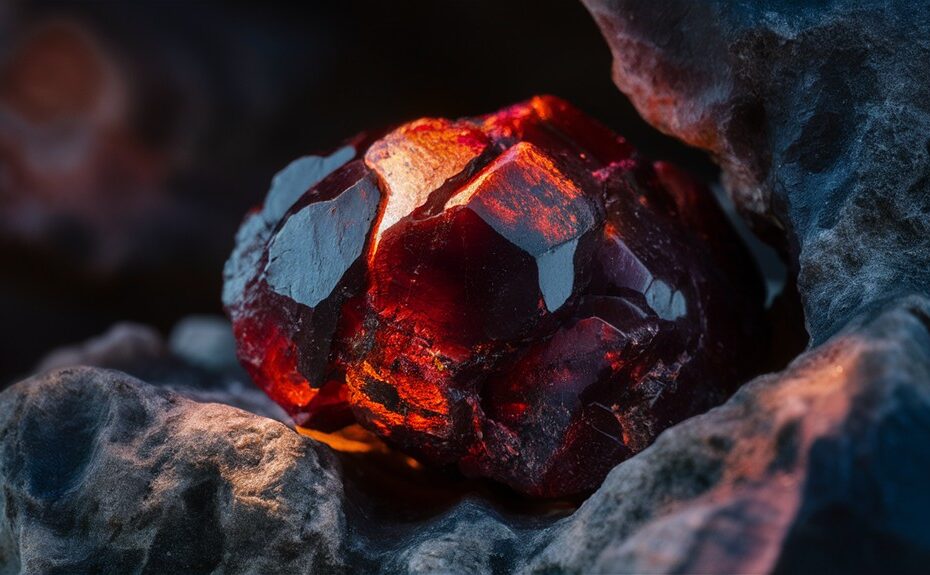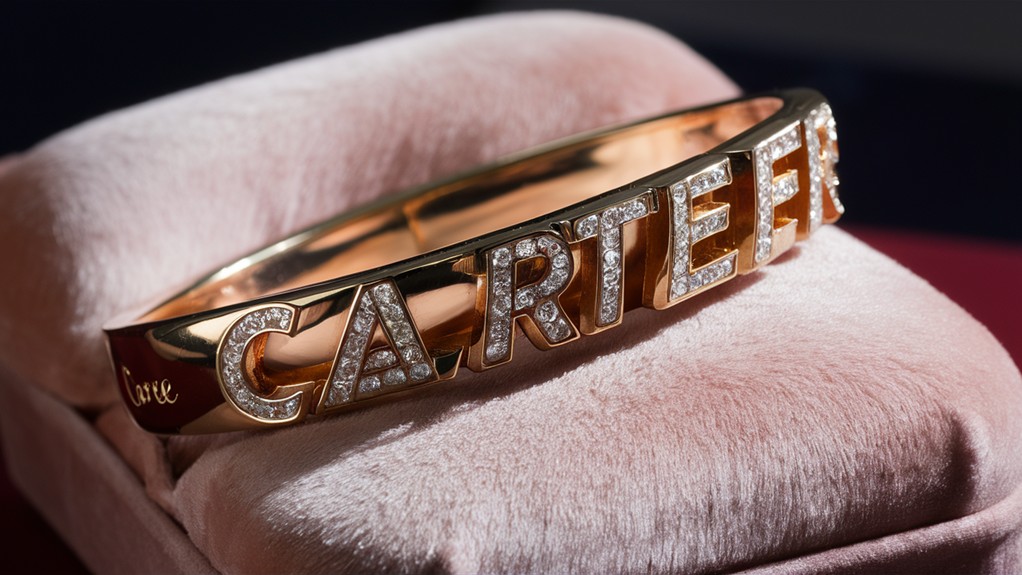You've likely encountered garnets in jewelry, but did you know there's more to these gemstones than meets the eye? Garnets aren't just red; they come in a rainbow of colors and varieties, each with its own unique charm and value. From the fiery reds of pyrope to the lush greens of tsavorite, garnets offer a world of beauty to investigate. Whether you're a jewelry enthusiast or a curious collector, understanding the types, colors, and factors that influence garnet value can transform your appreciation of these natural wonders. Let's uncover the secrets that make garnets so enchanting.
Our Highlighted Points
- Garnets come in various types, including tsavorite, pyrope, spessartite, rhodolite, and color-changing varieties, each with unique characteristics.
- Garnet colors range from deep reds to vibrant greens and oranges, with rarer hues commanding higher market values.
- Factors affecting garnet value include color intensity, clarity, origin, carat weight, and cut quality.
- Garnet formation occurs in metamorphic rocks under high pressure and temperature, influenced by specific geological conditions.
- Proper care and maintenance of garnet jewelry involves regular cleaning, safe storage, and periodic professional inspections.
Types of Garnet Gemstones
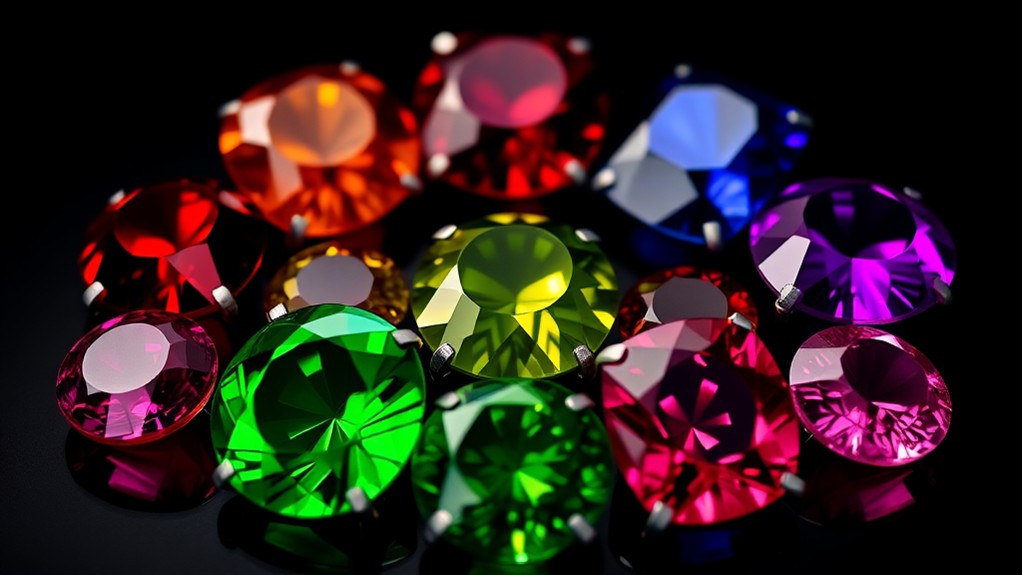
Garnet's versatility shines through its diverse range of types, each with unique characteristics. When exploring the world of garnet gemstones, you'll encounter several distinct varieties:
- Tsavorite: This brilliant green garnet, primarily sourced from Tanzania and Kenya, is prized for its rarity and vibrant color. With a hardness of 7.0 to 7.5 on the Mohs scale, it's suitable for everyday wear.
- Pyrope: Known for its intense red hue, pyrope garnets are highly sought after in fine jewelry. Their hardness of 7.5 makes them durable and long-lasting.
- Spessartite: Ranging from orange to reddish-brown, this garnet variety is mined in Brazil and Madagascar. Its vibrant colors and hardness of 7.0 to 7.5 make it a popular choice.
- Rhodolite: This violet-red garnet combines pyrope and almandine characteristics, offering both brilliance and durability with a hardness of 7.0 to 7.5.
- Color Changing Garnet: Unique for its ability to shift colors under different lighting conditions, this garnet variety is primarily found in East Africa and boasts a hardness of 7.0 to 7.5.
Garnet Colors and Varieties
While we've examined the different types of garnets, it's the stunning array of colors that truly sets this gemstone apart. Garnet colors span a wide spectrum, from the classic deep red to vibrant greens, oranges, and even color-changing varieties. You'll find that each hue offers its own unique beauty and value in the gemstone market.
Among the most prized varieties, you'll encounter the tsavorite garnet, renowned for its vivid green color. This rare garnet owes its striking appearance to trace amounts of vanadium or chromium.
If you're drawn to warmer tones, the spessartite garnet showcases a range of orange to reddish-brown hues, making it an enchanting choice for jewelry.
For those seeking something truly extraordinary, color-changing garnets present an intriguing option. These gems shift their appearance under different lighting conditions, adding an element of intrigue to your collection.
When exploring garnet varieties, you'll uncover:
- The fiery brilliance of a deep red pyrope
- The lush, forest-like depths of a tsavorite
- The warm, sunset glow of a spessartite
- The mesmerizing transformation of a color-changing garnet
- The regal purple-red tones of a rhodolite
Factors Affecting Garnet Value
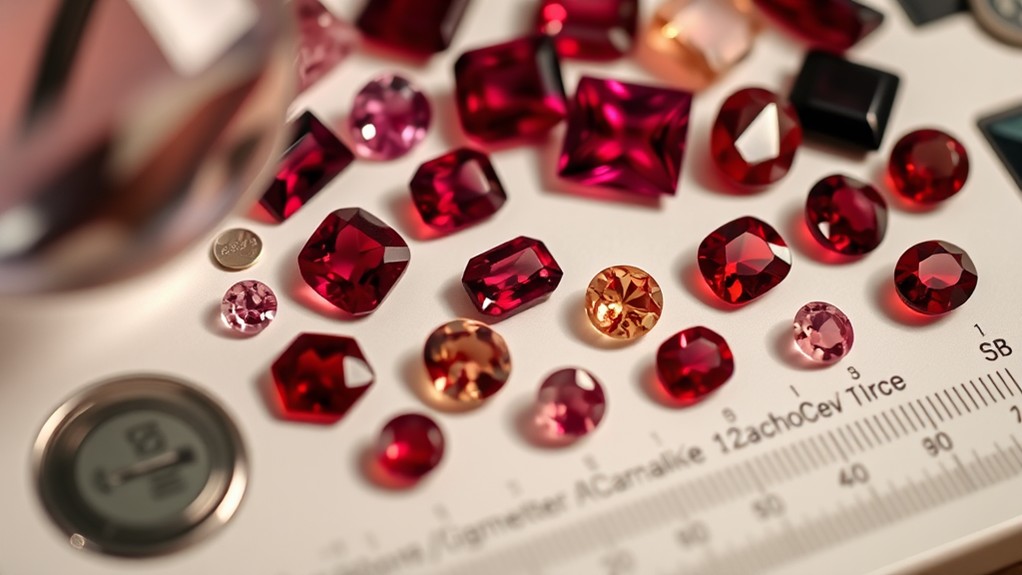
In relation to garnet value, several key factors come into play. The color of the garnet is essential, with rarer hues like tsavorite and demantoid fetching higher prices than common red varieties.
You'll find that clarity greatly influences value, as garnets with fewer inclusions, especially in larger sizes, are more sought after.
The origin of the garnet can impact its worth, with stones from renowned sources like East Africa or Sri Lanka often commanding premium prices because of their quality and reputation.
Carat weight is another important determinant; larger garnets, particularly gem-quality stones over several carats, are generally rarer and more valuable. In addition to carat weight, gemstone size conversion can also play a role in determining the value of a garnet. As with all gemstones, the size and proportions of a garnet can affect its appearance and perceived value. When considering gemstone size conversion, it’s important to factor in the various shapes and cuts that can affect how large a garnet appears, as well as the overall impact on its desirability and price.
Finally, the cut of the garnet plays an important role in its valuation. A well-executed cut that enhances the stone's brilliance and color will considerably increase its value compared to a poorly cut specimen.
When assessing a garnet's worth, consider these factors:
- Color: Rarity and intensity
- Clarity: Presence and visibility of inclusions
- Origin: Reputation of the source
- Carat weight: Size and rarity
- Cut: Quality and light performance
Garnet Formation and Sources
Understanding how garnets form and where they're found adds another layer of appreciation for these magnificent gemstones. Garnet formation primarily occurs in metamorphic rocks under high-pressure and high-temperature conditions, often associated with tectonic processes. The chemical composition of garnets differs based on the specific elements present, including aluminum, calcium, iron, magnesium, manganese, and silicon. This variation influences their color and clarity, resulting in a wide array of garnet varieties.
Notable sources of garnets include Tanzania's Manyara Region and Kenya's Tsavo East National Park, where tsavorite garnet, a variety of grossular garnet, is primarily located. Madagascar has likewise emerged as a significant source, with additional deposits of distinct garnet types, including tsavorite.
Garnet formation is linked to geological events during the Neoproterozoic era, characterized by extensive rock folding and metamorphism.
As you investigate the world of garnets, consider the following:
- The immense pressure and heat required to create these stunning gems
- The intricate movement of elements that determines each garnet's unique properties
- The geological history spanning millions of years encapsulated in each stone
- The remote and often challenging locations where garnets are found
- The connection between Earth's dynamic processes and the beauty we admire in garnets
Historical Significance of Garnets

Throughout the annals of history, garnets have enchanted humanity with their rich hues and enduring allure. The historical significance of these gemstones stretches back to ancient times, with evidence of their use by Egyptian pharaohs and Roman nobility.
You'll find that the name "garnet" itself is rooted in history, derived from the Latin word "granatus," meaning seed, owing to the crystals' resemblance to pomegranate seeds.
Garnets have long been revered for their perceived protective qualities. During the Middle Ages, people believed these stones could ward off nightmares and evil forces. This mystical reputation raised garnets to the status of powerful talismans, thought to shield wearers from disaster and misfortune.
The enduring popularity of garnets across cultures and eras is an indication of their versatility and appeal. You'll realize that these gemstones have symbolized love, protection, and friendship throughout history, making them one of the oldest known and most cherished gemstones.
Their use in jewelry and decorative arts has persisted for millennia, cementing garnets' place in human culture and adornment.
Garnet Properties and Characteristics
While garnets have enchanted humans for millennia, their enduring appeal stems from their unique properties and characteristics. As members of the garnet group, these gemstones exhibit a cubic crystal structure and impressive hardness, ranging from 6.5 to 7.5 on the Mohs scale. This durability contributes considerably to their value and popularity in jewelry making.
One of the most intriguing aspects of garnets is their diverse color palette. While red garnets are the most common, you'll find these gems in an array of hues, including green, orange, yellow, purple, brown, and even blue. The refractive index of garnets, varying between 1.714 and 1.888, amplifies their brilliance and fire, further adding to their allure.
When assessing garnet value, consider these key factors:
- Clarity: Type II clarity, with potential for high-quality, inclusion-free specimens
- Specific gravity: Ranging from 3.930 to 4.300, influencing density and weight
- Color intensity: Vibrant, saturated hues command higher prices
- Cut quality: Precision cutting optimizes light return and brilliance
- Size: Larger stones often fetch premium prices per carat
Understanding these garnet properties will help you appreciate the unique characteristics of these fascinating gemstones and make informed decisions when purchasing or collecting them.
Caring for Garnet Jewelry
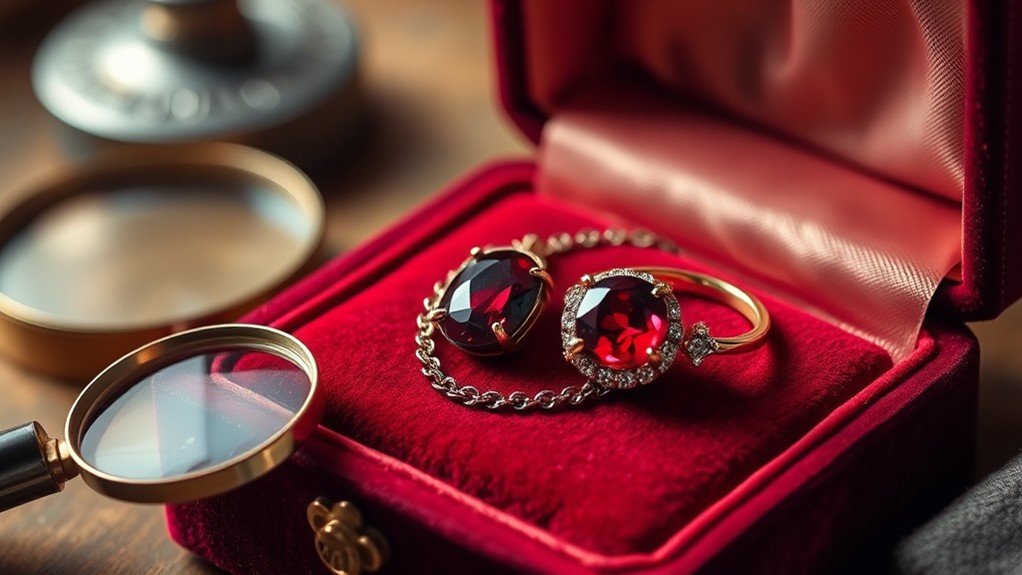
To guarantee your garnet jewelry retains its beauty and value for years to come, proper care and maintenance are vital. Regular cleaning is important to maintain the stone's brilliance and clarity. Clean your garnet pieces using a solution of warm, soapy water and a soft cloth, gently wiping the surface to remove dirt and oils.
Avoid using harsh chemicals or ultrasonic cleaners, as these can damage the garnet's surface and compromise its integrity.
When storing your garnet jewelry, keep pieces separate from other gemstones to prevent scratches and damage from harder materials. Regularly inspect garnet settings and stones for signs of wear or damage, ensuring any loose stones are promptly secured by a professional jeweler.
Be mindful of environmental factors that can affect your garnet jewelry:
- Limit exposure to direct sunlight, as prolonged periods can lead to color change or fading in certain varieties.
- Remove garnet jewelry before engaging in activities that may subject it to impact or abrasion.
- Avoid exposing garnets to extreme temperature changes, which can cause internal stress.
Garnet Treatments and Enhancements
Understanding garnet treatments and improvements is a vital aspect of appreciating these gemstones. Most garnets remain untreated, preserving their natural beauty and value. However, some varieties, particularly demantoid garnets, may undergo heat treatment to improve their color and market appeal.
As a collector or buyer, it's essential to be aware of these treatments, as they can greatly impact a stone's value and desirability.
Natural garnets are generally preferred in the market, often commanding higher prices because of their perceived authenticity. Treated stones, while potentially more visually appealing, may be less valuable. When purchasing garnets, always inquire about any treatments or improvements the stone may have undergone.
To fully appreciate the world of garnet treatments and improvements, consider the following:
- The rarity of untreated, natural garnets
- The potential for better aesthetics through treatments
- The ethical implications of altering natural gemstones
- The impact of treatments on a garnet's long-term value
- The importance of transparency in the gemstone market
Choosing the Right Garnet
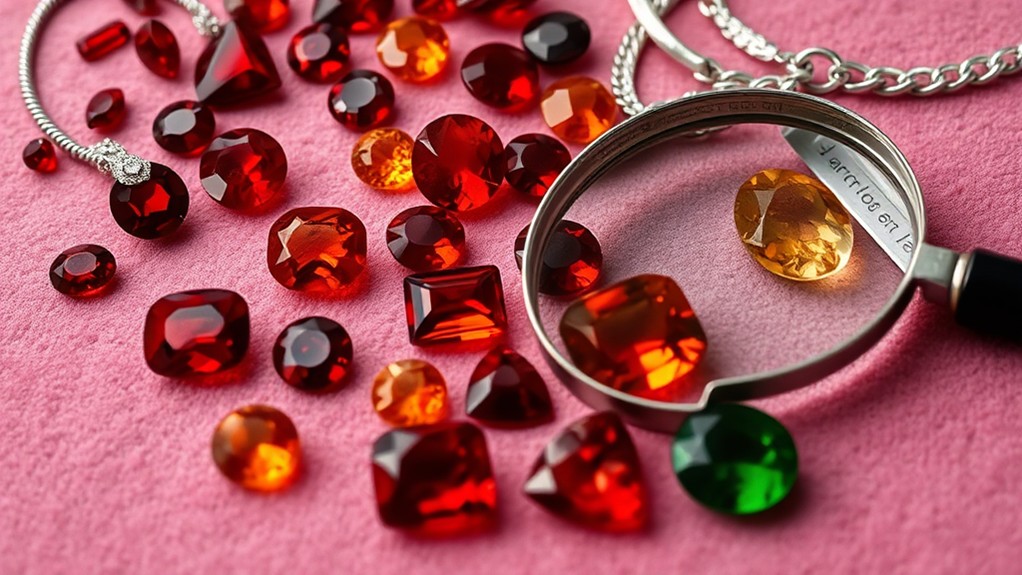
Selecting the perfect garnet involves considering five key factors: color, clarity, type, cut, and treatment status.
When evaluating color quality, prioritize vibrant and well-saturated hues, with red garnets being the most sought after. Inspect the clarity of the stone, aiming for minimal inclusions, as higher clarity grades notably increase value.
Consider the type of garnet you're purchasing. Rarer varieties like tsavorite and demantoid often command higher prices compared to more common types such as almandine and pyrope.
The cut of the garnet is vital; well-cut stones exhibit better brilliance and light performance, improving general appeal.
Garnets are typically untreated, making treatment disclosures important. Untreated garnets, especially those with rare colors, are generally more valuable than improved stones.
When examining potential purchases:
- Assess color saturation and vibrancy
- Check for visible inclusions
- Identify the specific garnet variety
- Evaluate the quality of the cut
- Confirm treatment status with the seller
Frequently Asked Questions
How Do I Know if My Garnet Is Valuable?
To determine your garnet's value, examine its color, clarity, carat weight, and cut quality. Rare colors like green are more valuable. Look for fewer inclusions, larger size, and excellent cut. Consider having it professionally appraised for accuracy.
What Is the Most Expensive Garnet Color?
You'll find that the most expensive garnet color is typically vibrant green. Tsavorite and demantoid garnets command the highest prices, with top specimens fetching thousands per carat. Their rarity and unique hues make them highly sought after.
What Are the Rare Colors of Garnet?
You'll find that rare garnet colors include vibrant green tsavorite, blue garnets with color-changing properties, and unique color-shifting varieties from Tanzania. Don't forget about the less common spessartite garnets, which display striking orange to reddish-brown hues.
What Are the Different Shades of Garnet Gems?
You'll find garnets in a rainbow of shades. They're commonly red, but you can uncover them in orange, green, purple, and yellow. You might even spot rare color-changing varieties or uncommon black, brown, and colorless garnets.
